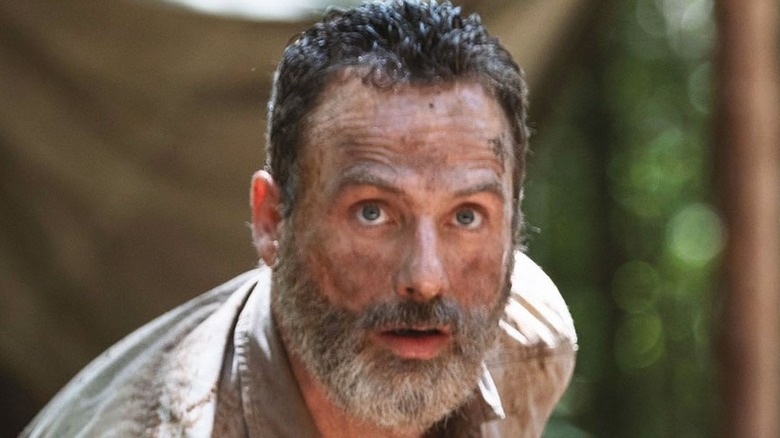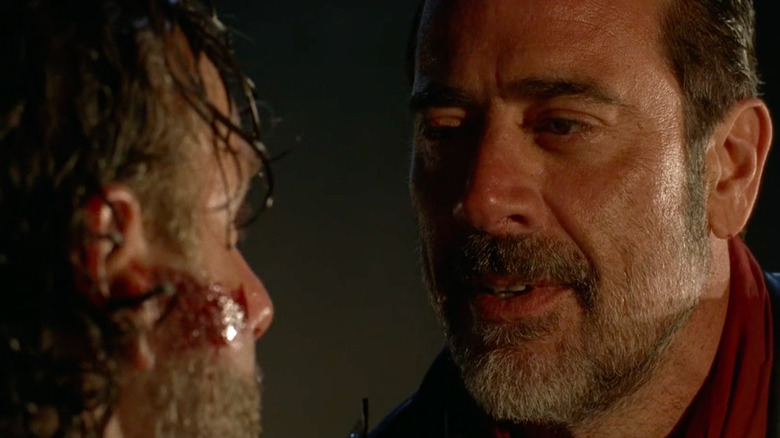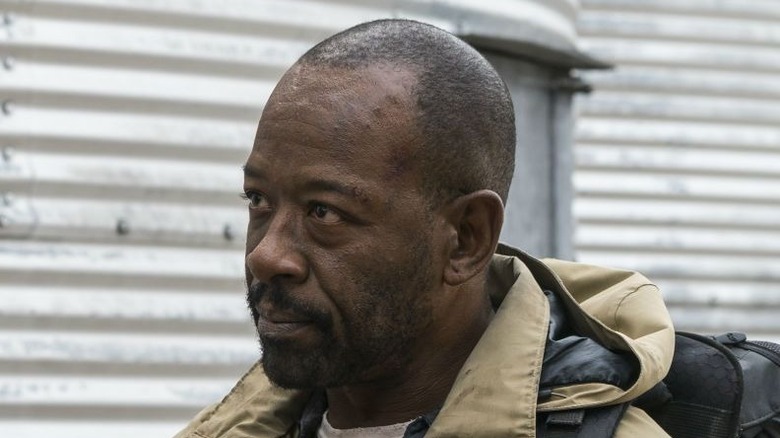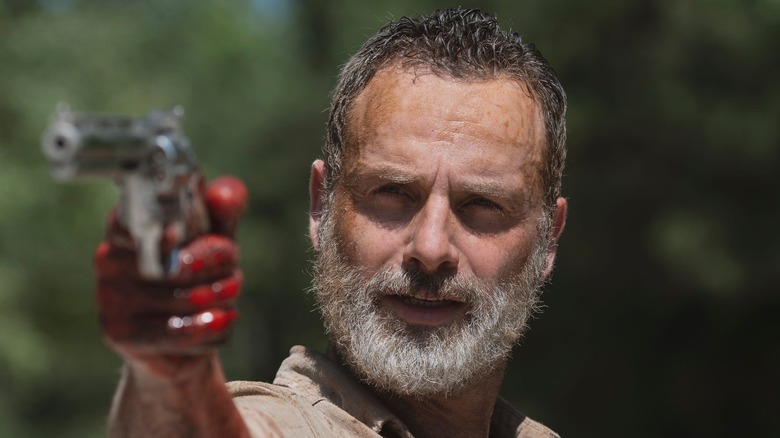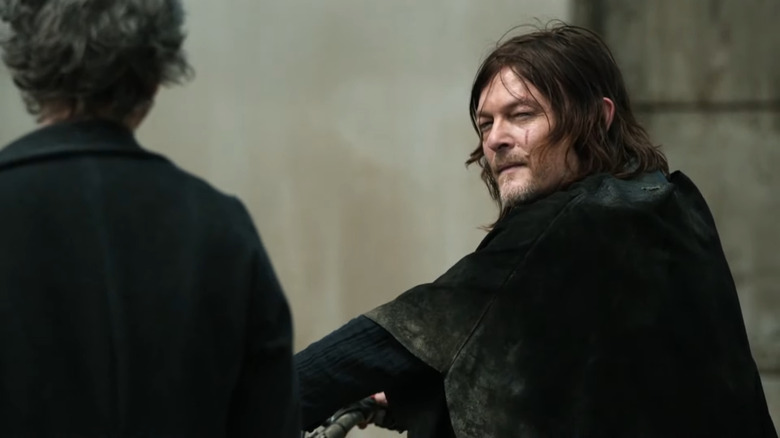The Entire Walking Dead Timeline Finally Explained
More than 10 years and 11 seasons in, "The Walking Dead" has a complicated mythos and a somewhat difficult-to-follow timeline. That's before the spin-off shows like "Fear the Walking Dead" and "The Walking Dead: World Beyond" are included. Each show includes its own timeline jumps, flashbacks, and storytelling quirks, and the franchise as a whole tends to explore the fallout of the zombie apocalypse through small-scale, personal stories. Piecing together the big picture can be a challenge, especially when the show doesn't go out of its way to clarify the specifics for its audience.
So far "The Walking Dead" has journeyed 13 years into the apocalypse. Throughout the years, the world's survivors have faced countless members of the undead, multiple wars with other humans, and even a nuclear explosion or two. By this point it's clear that society will never go back to what it was before, but at the same time, new societies are beginning to really take shape. Humanity isn't finished yet, but they do have a long road ahead of them. Here's the timeline of "The Walking Dead" franchise finally explained.
The outbreak
Even after more than a decade on the air and multiple spin-off shows, "The Walking Dead" still hasn't revealed the true origin of the Wildfire virus that brought about the zombie apocalypse. In the penultimate episode of "The Walking Dead" Season 1, CDC scientist Dr. Jenner reveals that the virus has been spreading worldwide for at least 190 days. Before communication lines went down, French scientists broadcast that they believed they were close to developing a cure, but no one knew where the virus had originated.
Dr. Jenner learned through his research that the virus had gone airborne. In the Season 1 finale "TS-19," he tells Rick that everyone is infected. No matter how they die, all of them will rise again as walkers. The discovery goes a long way towards explaining how the virus toppled societies all around the world so quickly. The virus spread exponentially and grew from a quirky radio news story that Rick hears in the beginning of "Days Gone By" to a cataclysmic event in mere weeks.
Immediate aftermath
Andrew Lincoln's legendary Rick Grimes spends roughly the first two months of the outbreak in a coma. When he wakes up in the hospital, society has entirely collapsed. He's only alive because Shane barricaded his hospital room before helping Laurie and Carl get out of town. Rick missed the immediate aftermath of the outbreak, but he quickly gets up to speed on the CliffNotes of what went down.
In 2015, "Fear the Walking Dead" decided to explore the early days that Rick and his fans missed when "The Walking Dead" first aired in 2010. The spin-off show opens just as the Wildfire virus is beginning to infect people in the United States. At first most people don't know anything about what's going on, and no one believes Nick Clark when he tells them that his zombified girlfriend was eating people.
"Fear the Walking Dead" spends most of its first three seasons catching up to the time where Rick's journey begins. Along the way, the show reveals that society more or less collapsed within three weeks of the Wildfire outbreak. In "Cobalt," it's revealed that the military plans to evacuate the LA Basin and bomb the area to kill the infected. In the Season 2 episode "We All Fall Down," the plan is scaled up and all the major coastal cities in North America are destroyed, but it's not enough to stop the walkers.
First year of the apocalypse
"The Walking Dead" took its time exploring the first year that Rick Grimes and his group spent surviving the zombie apocalypse. Season 1 follows Rick into Atlanta as he tries to find his family and then back into the overrun city when they try to shelter at the CDC. After the CDC explodes, Rick and the group are on the road until they cross paths with Hershel's family when Sophia gets lost and Carl gets shot.
While Season 2 feels like it lasts a decade, it really spans just a few weeks. The group spends the first winter of the apocalypse on the road again until they find the prison and decide to make a new home for themselves. As they attempt to do so in Season 3, Rick's group comes face to face with the Governor. The conflict with Woodbury burns itself out after a few months: Along the way, Rick loses his wife Lori in childbirth, and Daryl's brother Merle chooses to betray the Governor at the expense of his own life. Season 3 concludes about a year after Rick got shot at the beginning of the outbreak.
The rest of the world's action during the first year of the apocalypse happens mostly offscreen or is shown during flashbacks in later seasons. Negan loses his wife and begins his journey to The Sanctuary. Abraham, Rosita, and Eugene all meet and begin heading toward Washington, D.C. Deanna Monroe and her husband organize the community at Alexandria and put up the wall. Hilltop, the Kingdom, and presumably the Commonwealth all take formation. There's still a difficult road ahead for the world.
The road to Terminus
Later seasons in "The Walking Dead" take huge strides forward in time, sometimes even including big time jumps within a single season. It can be easy to forget that there were times when "The Walking Dead" crawled along at a snail's pace — without sacrificing any of its entertainment value. Season 4 takes place over less than two weeks, but they might be the hardest weeks that Rick's group experiences.
The story begins about six months after the end of Season 3. The people of Woodbury have moved into the prison, a governing council has been formed, and Rick Grimes has decided to take a back seat to the action and work on farming with Carl. Then a virus of the more traditional variety decimates the population at the prison. The group loses a majority of their people, but just when they're really beginning to recover, the Governor returns and permanently destroys the home they've built.
For the back half of the season, the group is separated and on the road. Glenn meets Abraham, Eugene, and Rosita, and they help reunite him with Maggie. Daryl and Beth travel together until she's taken by officers from Grady Memorial Hospital. Everyone follows signs for a mysterious community called Terminus, and they all finally meet back up in a train car after becoming prisoners of the community.
Finding a new home
Unfortunately for the heroes of "The Walking Dead," their hardships didn't get any easier during the show's 5th season. Terminus, as it turns out, is a community of cannibals, and the group is only able to make their escape with a violent confrontation. After that, almost everyone is back together and hiding out in Gabriel's church, but Beth is still trapped inside Grady Memorial Hospital with Noah and the others that Officer Dawn refuses to let leave.
The Season 6 episode "Here's Not Here" reveals that around this time, Morgan is living with a man named Eastman and learning how to define himself in the new world and heal from his violent past. When Eastman dies, Morgan begins traveling in the direction of Rick's group, though he doesn't know it at the time. Meanwhile, Rick and the others lose Beth in a confrontation with Dawn at the hospital. With nothing left for them in Georgia, the group decides to head north towards D.C., where Noah's family had lived inside a gated community.
By the time they arrive at Noah's home, the entire community has been overrun by walkers, and Noah's family is dead. Disheartened and running low on supplies, the group decides to continue onwards to D.C. proper, but along the way they're approached by Aaron, a recruiter from Alexandria, and invited into the community. Not long after Rick's group arrives, Morgan also finds his way to the community, and they all begin working to guarantee that their new home remains safe.
War with the Saviors
Rick and his friends manage to help Alexandria survive a herd of zombies and an attack from a gang known as the Wolves, but unfortunately the peace that follows does not last long. The Saviors are first introduced in Season 6, when Rick and the others learn that they've been extorting supplies from the Hilltop community. There are scattered confrontations with the Saviors throughout the season, but the conflict reaches a head in the finale and the Season 7 premiere, "The Day Will Come When You Won't Be." Negan reveals himself as the leader of the Saviors, kills Glenn and Abraham, and essentially takes control of Alexandria.
The war with the Saviors is another example of "The Walking Dead" slowing down and spending a lot of screen time exploring events that occur in a short period of time. The war stretches through the entirety of Seasons 7 and 8, but Rick's group doesn't spend years under the Saviors' control. Instead, Alexandria unites forces with the other communities and overpowers the Saviors in a little more than a month. During these seasons, we lose many beloved characters, including Sasha Williams and, devastatingly, Carl Grimes. Negan is taken to Alexandria as a prisoner.
Apocalypse Year 3
The 4th season of "Fear the Walking Dead" aired between Seasons 8 and 9 of "The Walking Dead." The spin-off abandons its focus on the earliest days of the zombie apocalypse and skips forward to a time shortly after the end of the war with the Saviors. "Fear the Walking Dead" Season 4 unites characters from the show's first three seasons with some characters from the main series, most notably Morgan Jones, who leaves Alexandria after the war hoping to find a less violent life away from people.
He doesn't get his wish, as Morgan is quickly pulled into a new conflict with a group called the Vultures. "Fear the Walking Dead" Season 4 takes place near the beginning of the apocalypse's third year, and Season 5 jumps ahead closer to the end of the year. Together, the seasons help to fill in the gap in time between "The Walking Dead" Seasons 8 and 9. They also demonstrate that the struggles Rick and his group faces are common across the United States in the new world.
Big changes and an explosive goodbye
There's a large time gap between the end of "The Walking Dead" Season 8 and the beginning of Season 9. A little more than a year passes as the communities adjust to their new, cooperative way of life. Rick is struggling to keep the communities working together on a bridge project that will make travel between them infinitely easier. The project is ultimately doomed to fail.
Pursued by a massive herd of zombies, Rick is forced to sacrifice himself and blow up the bridge in order to save his people. A scene in Rick's final episode "What Comes After" reveals that he's been airlifted away in a helicopter manned by unknown forces, but all of his friends believe he's dead. The very next episode marks the biggest time skip in the series: It jumps forward about six years. Judith is now about as old as Carl was when the series began, and the communities have entirely pulled away from each other.
Meanwhile, Season 6 of "Fear the Walking Dead" includes several time skips that catch the spin-off series up to the point of Rick's "death." The season ends with one of the most dramatic events in the entire franchise. Multiple nuclear warheads are set off near Morgan and the other survivors. Season 7 will reveal if and how they survive the blasts, and what world this new kind of apocalypse will create.
The Walking Dead: World Beyond
"The Walking Dead: World Beyond" is planned as a two-season spin-off focused on the generation of kids who are coming of age during the zombie apocalypse. The 1st season aired in October 2020 and is set exactly ten years after the initial outbreak of the Wildfire virus. That puts "World Beyond" in the nebulous span of time between Rick Grime's apparent death in "What Comes After" and the continuation of "The Walking Dead" series that begins in "Who Are You Now?"
"World Beyond" is set in Nebraska and features a new group in the mythos of "The Walking Dead." The Civic Republic Military (CRM) are a pseudo-government organization trying to bring peace and order to the apocalypse. They have plenty of people and resources, including helicopters branded with the same logo as the helicopter that Jadis called in to rescue Rick. What the CRM is really up to and what they've done with Rick remains a mystery, but their presence in "World Beyond" shows that the franchise is interested in telling larger stories about the world as a whole in the zombie apocalypse.
What happens in the 6-year gap
"The Walking Dead" takes its time revealing what happened between Rick blowing up the bridge and the events of "Who Are You Now?" At some point, Michonne realizes that she's pregnant with Rick's child and gives birth to R.J. The communities try, for a while, to continue working together, but Michonne eventually decides that Alexandria will take an isolationist approach to everyone else in order to keep the community safe. Negan has remained imprisoned there for over seven years and formed a close bond with Judith. After he saves Judith's life in a blizzard, he earns a reluctant place helping out in the Kingdom's community.
Carol moves to the Kingdom where she and Ezekiel raise Henry as their own son. Daryl spends most of the in-between years living out in the woods, searching desperately for Rick's body. He never finds the body, but he does bond with a woman named Leah and her dog, Dog, before Leah goes missing and Dog is left in Daryl's care. The reformed Saviors join the various communities working for survival, but as the years drag on, everyone begins to realize that the communities need to find a way to cooperate once again.
Year 13
While they aren't perfect, the years breezed by in the big time skip are relatively calm and peaceful for all the survivors on "The Walking Dead." That peace is broken as the apocalypse approaches its 13th year, and the Whisperer War is the most violent and destructive conflict in the history of "The Walking Dead." The fight against Negan may have been more emotionally impactful for some of the characters on the show, but the Whisperers take much more away from the surviving communities, most notably in the fair massacre near the end of Season 9.
The season concludes with Alpha establishing new borders for the communities and the Kingdom finally falling after years of dwindling resources and structural disrepair. "The Storm" sees the communities at their lowest point since the war with the Saviors, and without the resources to fight Alpha, they abide by her rules for the better half a year. In Season 10, the communities finally work together to resist Alpha, and the fighting carries them into the apocalypse's 13th year. The survivors defeat the Whisperers — with help from a surprising ally, Negan — but it costs them Hilltop and the walls that surround Alexandria. By the end of Season 10, the communities are still alive, but their position is more precarious than it has been in years.
The road beyond
As the apocalypse stretches into Year 13, "The Walking Dead" enters its 11th season. Eugene, Ezekiel, Yumiko, and Princess (whom the former three meet on their journey) are all trying to enter a massively resourceful community called the Commonwealth in the hopes that they'll be able to get some assistance for Alexandria and the people who were displaced from the Kingdom and Hilltop. Maggie has returned to Alexandria with some new friends because their home was destroyed by a group of violent survivors who call themselves the Reapers. Maggie believes that with some help, she can reclaim that home and use its resources to help Alexandria.
In the wider world of "The Walking Dead," there are still plenty of unknowns. Michonne has recently discovered that Rick might be alive, and she's gone off on a journey to find him. Morgan is likely battling through irradiated zombies somewhere in the American Southwest. The CRM is still trying to reform society, and it looks as though the Commonwealth is doing the same. Everyone has faced unimaginable loss, but the world is busier and more populated than it's been since before the outbreak of the Wildfire virus. The only thing that's certain is that there's much more danger, action, and hopefully triumph to come.
Leah and the Reapers
The final season of "The Walking Dead" debuted in three segments over the course of a year. The first third of the season focuses on wrapping up Maggie's struggles with the group that destroyed her new home and forced her to return to Alexandria. The pack calls themselves the Reapers and they're led by a grim man who calls himself Pope. The pseudo-religious organization of the Reapers sets them apart from anything else our survivors have encountered before, and their fanaticism makes it impossible to negotiate an end to their conflict.
Maggie takes a group of Alexandrians — including Gabriel, Daryl, and Negan — back to her old camp, believing that together they can defeat the Reapers and reclaim supplies that Alexandria desperately needs. As is usually the case for the heroes on "The Walking Dead," nothing goes as planned. Traveling to Maggie's camp means traversing a walker-infested subway tunnel, and some of the survivors die along the way. As soon as the group reaches Maggie's camp, the Reapers attack, scattering everyone apart and claiming another few lives in the process.
In a surprising twist, Daryl realizes that Leah, the woman he had a relationship with in the Season 10 episode "Find Me," is a member of the Reapers. He sees an opportunity to end the conflict peacefully, but that option goes out the window when Maggie kills more of Leah's people. Ultimately, Daryl kills Leah, and everyone returns to Alexandria with the supplies.
The nuclear option
The citizens of Alexandria may be going through a rough patch, but their problems are fairly minor compared to what is happening to the characters in "Fear the Walking Dead." In the wake of multiple nuclear detonations, Texas is an irradiated wasteland. Morgan and his friends are struggling more than ever just to survive, and that's without taking the radioactive walkers that now patrol the wastes into account.
Season 7 of "Fear the Walking Dead" is largely centered on the remnants of the Texas survivors falling into conflict with each other. Strand has taken control of a massive tower and he uses a horde of walkers as a moat to maintain his control. A dangerous group called the Stalkers lurks outside the tower, robbing and killing anyone they encounter.
As the season progresses, Morgan's efforts to keep his friends alive get him wrapped up in the search for something called PADRE — an organization created pre-Fall that supposedly has all the resources anyone might need to get some form of civilization restarted. Eventually, Strand's control over the tower falls apart and the refuge there crumbles. Morgan and some of his companions find their way to Louisiana, where they have the opportunity to go see PADRE for themselves. Unfortunately, there are signs that while it may have all the resources rumors claim, it's not exactly working in the best interests of the post-apocalyptic survivors we've come to love.
Trouble in the Commonwealth
As Morgan contends with unimaginable obstacles in Texas, the survivors in Alexandria are confronted with something equally unimaginable — a functional city of 50,000 human beings. In their efforts to find new supplies that can keep Alexandria afloat, the survivors discover the Commonwealth which promises to deliver everything that the old world had to offer.
The Commonwealth's promise turns out to be all too true. While there's relative peace and abundance in the settlement's walls, there's also rampant political corruption and a brewing class war. The settlement is led by Pamela Milton and her second-in-command Lance Hornsby. Milton will do anything to maintain her and her son's status as elite citizens, even if it means condemning the poorest Commonwealth citizens to endless work in labor camps. Hornsby dreams of having even more power, and he begins exercising an iron grip on the outside settlements, destroying Oceanside and transforming Alexandria into a town-sized prison in his pursuit of Milton's approval.
As soon as the Alexandrians get involved in the Commonwealth, they begin unearthing the corruption and conspiracies hiding underneath the settlement's surface. That puts them at odds with the Miltons and Hornsby, but the Alexandrians have never been ones to back down from a fight. They recognize the promise of the Commonwealth, and they believe that by standing up to its evil leaders, they can form a society better than anything the old world had to offer.
Going global
The survivors of "The Walking Dead" have gone through countless battles, believing each time that it would prove to be a turning point that guarantees them peace and happiness in the future. This time, they may be right. The Alexandrians stood with the people of the Commonwealth and challenged the settlement's leadership. Together they ousted Pamela Milton and Lance Hornsby. By the end of season 11, Ezekiel is the leader of a Commonwealth that is finally a true democracy working for the betterment of its citizens.
"The Walking Dead" may be over, but its universe lives on and will only be growing in the future. A spin-off starring Jeffrey Dean Morgan and Lauren Cohan will take Maggie and Negan to New York City. Another spin-off will follow Daryl Dixon to France and give "The Walking Dead" universe a whole new perspective on the zombie apocalypse.
Most exciting of all, a spin-off focused on Rick and Michonne will finally answer questions that have been lingering in fans' minds since Rick was dramatically taken off "The Walking Dead" in Season 9. There are still walkers to fight for survivors to organize into something like a cohesive society, and the new focus of "The Walking Dead" universe will show viewers the apocalypse on a global scale.
